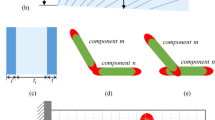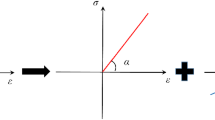Abstract
This paper presents a method to optimize the topology of structures under multiple load cases with stress constraints. Fiber-reinforced orthotropic composite is employed as the material model to simulate the constitutive relation of truss-like continua. The fiber densities and orientations at the nodes are taken as design variables. First, for each load case, the fiber orientations are aligned with the orientations of principal stress and the fiber densities are adjusted according to the strains along the fiber orientations. Then, to optimize the structure, the fiber densities and orientations under multiple load cases are determined by constraining its elastic matrix to approach the elastic matrix of the optimum structures defined for each single load case. Finally the member distribution in the optimal structure is suggested by the continuous lines formed according to the fiber densities and orientations. Several examples are presented to demonstrate the effectiveness of the proposed approach.
Similar content being viewed by others
References
Allaire G, Jouve F, Maillot H (2004) Topology optimization for minimum stress design with the homogenization method. Struct Opt 28:87–98
Bendsφe MP, Kikuchi N (1988) Generating optimal topologies in structural design using a homogenization method. Comput Meth Appl Mech Engng 71:197–224
Bendsφe MP, Diaz AR, Lipton R, Taylor JE (1995) Optimal design of material properties and material distribution for multiple loading conditions. Int J Numer Meth Engng 38:1149–1170
Bendsφe MP, Guedes JM, Haber RB etc. (1994) An analytical model to predict optimal material properties in the context of optimal structural design. J Appl Mech 61:930–937
Duysinx P, Bendsφe MP (1998) Topology optimization of continuum structures with local stress constraints. Int J Numer Meth Engng 43:1453–1478
Eschenauer HA, Olhoff N (2001) Topology optimization of continuum structures: A review. Appl Mech Rev 54:331–389
Guedes JM, Taylor JE (1997) On the prediction of material properties and topology for optimum continuum structures. Struct Opt 14:193–199
Hull D (1981) An introduction to composite materials, Cambridge University Press, New York
Hörnlein HREM, Kočvara M, Werner R (2001) Material optimization: bridging the gap between conceptual and preliminary design. Aerosp Sci Technol 5:541–554
Hsu Y, Sho M, Chen C (2001) Interpreting results from topology optimization using density contours. Comput Struct 79:1049–1058
Pedersen P (2004) Examples of density, orientation, and shape-optimal 2D-design for stiffness and/or strength with orthotropic materials. Struct Opt 24:37–49
Prager W (1974) A note on discretized Michell structures. Comput Meth Appl Mech Engrg 3:349–355
Querin OM, Young V, Steven GP, Xie YM (2000) Computational efficiency and validation of bi-directional evolutionary structural optimization. Comput Meth Appl Mech Engrg 189:559–573
Rozvany GIN (2001) Aims, scope, method, history and unified terminology of computer-aided topology optimization in structural mechanics. Struct Opt 21:90–108
Taylor JE (1998) An energy model for optimum design of linear continuum structures. Struct Opt 16:116–127
Xie YM, Steven GP (1994) Optimal design of multiple load case structures using an evolutionary procedure. Eng Comput 11:295–302
Xie YM, Steven, GP (1993) A simple evolutionary procedure for structures optimization. Comput Struct 49(5):885–896
Zhou K, Hu Y (2002) A method of constructing Michell truss using finite element method. Acta Mechanica Sinica 34:935–940 (in Chinese)
Zhou K, Li J (2004) The exact weight of discretized Michell trusses for a central point load. Struct Opt 28: 69–72
Author information
Authors and Affiliations
Corresponding author
Rights and permissions
About this article
Cite this article
Zhou, K., Li, X. Topology optimization of structures under multiple load cases using a fiber-reinforced composite material model. Comput Mech 38, 163–170 (2006). https://doi.org/10.1007/s00466-005-0735-9
Received:
Accepted:
Published:
Issue Date:
DOI: https://doi.org/10.1007/s00466-005-0735-9




